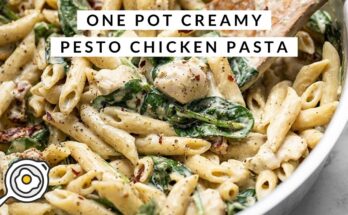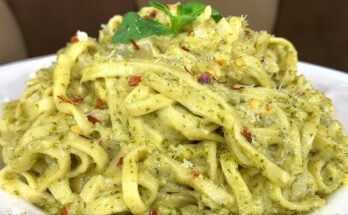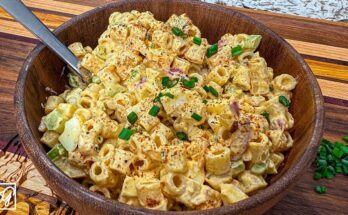Egg Roll Bowl Recipe: Imagine the delicious filling of an egg roll—savory meat, crunchy veggies, garlic, and ginger—all tossed together in a single bowl. Now, take away the wrapper, and you’ve got an “Egg Roll Bowl.” This deconstructed version of the traditional egg roll is everything you love without the hassle of frying or wrapping. It’s a flavorful, low-carb, and incredibly satisfying meal you can whip up in under 30 minutes. It combines everything great about stir-fry, with a fun twist that’s perfect for busy weeknights or meal prepping for the week ahead.
This dish has gained popularity because it delivers all the taste of your favorite Chinese takeout but with fewer carbs and more nutrition. It’s also very flexible, allowing you to swap ingredients according to what you have in your fridge or pantry. From keto lovers to busy parents, the egg roll bowl appeals to just about everyone.
Why You’ll Love This Recipe
Let’s be honest—who doesn’t want a fast, easy, and tasty dinner option? This egg roll bowl recipe hits all the right notes. First off, it’s incredibly simple. You’re just chopping, sautéing, and seasoning. No deep frying. No egg roll wrappers. No stress.
Secondly, it’s endlessly customizable. Whether you want to go meatless, reduce the carbs, or kick up the spice level, this recipe can be adjusted without much effort. It’s also budget-friendly, requiring basic ingredients that are either already in your kitchen or easy to find at any grocery store.
Lastly, it’s a one-pan meal. That means less cleanup and more time to relax. Whether you’re cooking for yourself, your family, or meal-prepping for the week, this bowl delivers the goods every single time.
Ingredients You’ll Need
Protein Options
Your choice of protein sets the tone for your egg roll bowl. Most people use ground pork, which closely mimics the traditional egg roll flavor. But don’t stop there—ground beef, chicken, turkey, or even tofu work wonderfully. If you’re feeling adventurous, you can mix proteins like pork and shrimp or try thinly sliced beef strips for a beef-and-broccoli fusion twist.
Ground meats are ideal for this recipe because they cook quickly and absorb the sauce beautifully. However, if you’re going plant-based, tofu or tempeh are excellent choices. Just make sure to press the tofu well before cooking to avoid excess moisture in the pan.
Vegetables and Add-ons
The vegetable base is where your egg roll bowl gets its texture and bulk. The classic combo includes shredded cabbage (green or red), carrots, and onions. You can buy a pre-packaged coleslaw mix to save time, or shred your own veggies if you prefer fresh-cut crunch.
Want more variety? Add bell peppers, snap peas, mushrooms, or zucchini. The key is to keep the vegetables crisp yet tender—not mushy. This keeps the bowl fresh and vibrant.
Add-ons like green onions, bean sprouts, or chopped water chestnuts can provide that authentic egg roll texture. If you’re after extra fiber and volume, toss in a handful of kale or spinach near the end of cooking.
Seasonings and Sauces
The flavor magic happens with a few pantry staples: soy sauce (or tamari for gluten-free), sesame oil, garlic, and fresh ginger. These bring out that unmistakable Asian-inspired umami kick.
For a touch of heat, throw in some sriracha, red pepper flakes, or chili garlic sauce. A splash of rice vinegar adds tang, while a dash of hoisin sauce can add sweetness if you want more balance.
Don’t forget salt and pepper to taste. A drizzle of sesame oil at the end boosts aroma and depth—don’t skip it unless you’re cutting calories hard.
Kitchen Tools Required
You don’t need a gourmet kitchen setup to make this dish. Here’s what you’ll want on hand:
- A large skillet or wok – for cooking everything in one place
- Cutting board and knife – for prepping veggies and protein
- Grater or microplane – for fresh ginger and garlic (optional but worth it)
- Mixing bowl – to combine sauces if you want to prep ahead
- Spatula or wooden spoon – to stir-fry ingredients evenly
A food processor can be handy if you’re chopping lots of cabbage or carrots. But overall, the cleanup is minimal. One pan, one bowl, and you’re good to go.
Step-by-Step Cooking Instructions
Step 1: Prepare the Ingredients
Before turning on the stove, get all your chopping and prepping out of the way. Dice your onions, shred the cabbage and carrots (or open that coleslaw bag!), mince the garlic and ginger, and set everything in separate bowls for easy access.
If you’re using tofu, press it first to remove water, then cube it. For meat, make sure it’s thawed and ready to go. Mix your sauce ingredients (soy sauce, sesame oil, vinegar, spices) in a small bowl so you can toss them in quickly when the time comes.
This prep step is key. Once you start cooking, everything moves fast—so it’s worth spending a few extra minutes up front.
Step 2: Cook the Protein
Now that everything’s prepped, heat a tablespoon of oil in your large skillet or wok over medium-high heat. Once hot, add your protein of choice—typically ground pork, chicken, or beef—and break it up with your spatula. Cook until browned and fully cooked through, which usually takes about 6 to 8 minutes.
If you’re using tofu, add the cubes to the hot skillet and let them sear undisturbed for a few minutes to create a golden crust before flipping. This gives it a nice texture and prevents it from falling apart.
Season lightly with salt and pepper during this stage. If you want to infuse extra flavor, you can add a bit of the sauce mixture here to start building layers of taste. Once the protein is done, push it to the side or remove it temporarily if your skillet is on the smaller side to make room for the veggies.
Step 3: Sauté the Vegetables
Time to bring in that colorful veggie mix. In the same skillet, add a little more oil if needed, then toss in your onions first. Let them soften for about 2 minutes, then add your cabbage and carrots (or coleslaw mix). Stir-fry everything together for 4-5 minutes until the cabbage begins to wilt but still has some crunch.
If you’re adding extras like bell peppers or mushrooms, now’s the time. Keep stirring to ensure nothing sticks or overcooks. The goal is vibrant, slightly crispy veggies—not soggy ones.
At this point, your kitchen should be smelling absolutely amazing with the mix of sizzling garlic, ginger, and onion wafting through the air.
Step 4: Combine and Season
With your protein cooked and veggies sizzling, it’s time to bring it all together. Return the meat (or tofu) to the skillet if you set it aside, and mix everything well.
Now, pour in your sauce mixture. This is where the egg roll bowl starts to take on that classic takeout flavor. Stir continuously so the sauce coats every bite. Let it simmer for a couple of minutes so the flavors meld and the sauce slightly thickens.
Do a quick taste test—does it need more soy sauce? A splash of rice vinegar for brightness? Maybe a little heat from sriracha or red pepper flakes? Adjust as needed and cook for another 1-2 minutes to let it all come together.
Step 5: Final Touches and Garnishing
You’ve made it! The last step is adding those little extras that elevate your egg roll bowl from good to great. Drizzle with sesame oil right before serving to lock in that rich, nutty aroma.
Top with freshly chopped green onions, sesame seeds, or even some crushed peanuts for crunch. If you love spice, a few drops of chili oil will do the trick. Want to keep it light? A squeeze of lime adds a fresh, tangy kick that balances out the umami flavors perfectly.
Serve hot, straight from the skillet into bowls. And just like that—you’ve got a comforting, protein-packed, flavor-filled meal that tastes like it came from your favorite Asian restaurant.
Tips for the Best Egg Roll Bowl
Make It Low Carb or Keto
Trying to stay low carb or follow a keto lifestyle? This recipe already leans in that direction, especially if you skip the hoisin sauce (which contains sugar) and opt for coconut aminos instead of soy sauce. Coconut aminos have fewer carbs and add a subtly sweet umami flavor that’s perfect for this dish.
Instead of using regular carrots, which contain a bit more sugar, you can try julienned zucchini or shredded turnips. They still provide that satisfying crunch without the extra carbs. Another great idea is to add chopped mushrooms to increase bulk while keeping the carb count low.
Need to bump up your fat content? No problem—just increase the sesame oil slightly or add in a little avocado oil while cooking. This keeps the dish within your macros while adding rich flavor and satiety. Finish it with a runny fried egg on top for a beautiful keto-friendly touch that turns your egg roll bowl into a complete meal.
Meal Prep and Storage Tips
Egg roll bowls are a meal prepper’s dream. They store well, reheat easily, and actually taste better the next day as the flavors meld together. To meal prep like a pro, cook a double batch and portion it into airtight containers. It will last in the fridge for up to 4 days.
If you’re someone who gets bored eating the same thing every day, switch things up by changing the toppings. One day add a fried egg, another sprinkle crushed cashews or drizzle some spicy mayo.
Avoid freezing if you’re using cabbage, as it can turn mushy when thawed. However, if you must freeze, undercook the veggies slightly to preserve some of their texture.
Reheat in a skillet or microwave, but if you’re using the microwave, cover it with a damp paper towel to maintain moisture.
Variations and Customizations
Vegetarian and Vegan Alternatives
Going meatless doesn’t mean sacrificing flavor. Use firm tofu or tempeh as a hearty protein base. Both absorb flavors well and bring a satisfying bite to the dish. You can also try edamame for a protein punch or seitan if you want a chewier texture.
For a truly vegan-friendly sauce, swap out fish sauce (if you use it) for a splash of tamari and a dash of miso paste. It brings that same salty depth without any animal products.
Want to add more veggies? Load it up with shredded Brussels sprouts, chopped kale, or spiralized squash. Vegan egg roll bowls are all about balance—get your protein, fiber, and fat from plant-based ingredients and sauces.
Asian-Inspired Flavors and Twists
Craving a flavor upgrade? Try these quick ideas:
- Thai Style: Add Thai basil, lime juice, and crushed peanuts. Serve with a peanut sauce drizzle.
- Korean Style: Add a spoonful of gochujang paste, sesame oil, and kimchi for a spicy-sour kick.
- Japanese Style: Mix in a bit of miso paste and serve with pickled ginger or nori strips.
These simple additions keep the base recipe interesting and allow you to experience global flavors without starting from scratch. Just swap one or two ingredients and your taste buds will think you’re eating an entirely new dish.
Serving Suggestions
Sure, you can eat your egg roll bowl straight from the pan (and no one would blame you), but here are some ways to dress it up:
- Serve over cauliflower rice for a low-carb option.
- Pair with jasmine rice or brown rice for a heartier meal.
- Top with a sunny-side-up egg for breakfast vibes.
- Use it as a filling for lettuce wraps or low-carb tortillas.
- Serve alongside miso soup or an Asian cucumber salad for a complete dinner spread.
These options let you adjust the meal based on your mood, dietary needs, or what’s in your pantry.
Nutritional Benefits
One of the biggest wins of the egg roll bowl is its nutritional profile. Let’s break it down:
- Protein-packed: Whether you use pork, chicken, tofu, or turkey, this bowl delivers high-quality protein that keeps you full longer.
- Low in carbs: Especially if you skip the rice and stick with cabbage or cauliflower rice.
- Rich in fiber: Thanks to the cabbage, carrots, and add-on veggies.
- Healthy fats: Sesame oil not only adds flavor but also contributes to good fats that support brain and heart health.
- Low sugar: Unlike takeout versions drenched in sugary sauces, you control what goes in.
It’s a complete meal that supports your wellness goals, tastes amazing, and doesn’t feel like a compromise.
Common Mistakes to Avoid
Even the simplest recipes can go sideways. Here are a few common pitfalls to steer clear of:
- Overcooking the veggies: Soggy cabbage ruins the texture. Keep the sautéing time short and sweet.
- Skipping the prep: With a stir-fry style dish, timing is everything. Chop and measure first.
- Using too much sauce: It can turn the bowl into a salty soup. Start small—you can always add more.
- Forgetting the finish: A splash of sesame oil and sprinkle of green onion can take your bowl from basic to bomb.
- Not draining tofu: Watery tofu doesn’t brown well. Always press it before cooking.
Avoid these mistakes, and your egg roll bowl will come out perfect every time.
FAQs about Egg Roll Bowl Recipe
Can I freeze egg roll bowls?
Freezing isn’t ideal due to the cabbage becoming soggy. However, you can freeze the cooked meat separately and add fresh veggies when reheating.
How long will it last in the fridge?
Properly stored in airtight containers, it stays fresh for up to 4 days in the fridge.
What other sauces can I use?
Try teriyaki, sweet chili, Thai peanut, or even a dash of ponzu for different flavor profiles.
Can I make this spicy?
Absolutely! Add sriracha, red pepper flakes, or chili oil to bring the heat.
Is it kid-friendly?
Yes! Just skip the spicy ingredients and use a mild, slightly sweet sauce for a kid-approved meal.
Final Thoughts
The egg roll bowl is the kind of dish you’ll find yourself making again and again. It’s fast, healthy, flexible, and packed with bold, crave-worthy flavors. Whether you’re eating clean, watching your carbs, or just need a meal that delivers, this recipe has your back. Plus, the one-pan cleanup means less stress and more time to enjoy.
If you haven’t tried it yet, today’s the day. Customize it to your liking, play with flavors, and make it your own. Your taste buds (and your schedule) will thank you.



